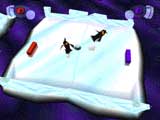 |
|
|
 Circa 1972: Pong debuts as the worlds first real "video
game." 1975: Home Pong is the hottest item in the Sears catalog. 1999:Pong returns to
the world of home gaming with a bang on the Playstation. Pong is pretty much a household
name now. In its heyday, it was famous for its "fast action" and "infinite
levels of play." Since then, the simple paddle game has been buried in the complex
world of 3D-shooters, near endless Role Playing Games and sports games that make you feel
like you're right on the sidelines. So in this empire of powerhouse video games, can the
veteran make a comeback? He sure can. Circa 1972: Pong debuts as the worlds first real "video
game." 1975: Home Pong is the hottest item in the Sears catalog. 1999:Pong returns to
the world of home gaming with a bang on the Playstation. Pong is pretty much a household
name now. In its heyday, it was famous for its "fast action" and "infinite
levels of play." Since then, the simple paddle game has been buried in the complex
world of 3D-shooters, near endless Role Playing Games and sports games that make you feel
like you're right on the sidelines. So in this empire of powerhouse video games, can the
veteran make a comeback? He sure can.
The first zone's levels continued from Penguin Pong to a Soccer game, Log rolling game and a Clown game where there isn't an computer controlled paddle. yup, you're playing solo. For the Clown game, the object is to sink colored balls that are spit from a clown's mouth into the matching colored bin on the sides of the play field. You can do this by bouncing them off of your paddle, or tilting the play field to the left or right. The zones continued on to feature levels such as "Rock N Roll," "Puck Pong," "Fishing Frenzy," and "Pinball Pong." The variety of levels was astounding. This is by far the game's finest feature. I would have never imagined that someone could create that many variations of one very simple game. Game play for pong was good; there were a few levels that made the paddles a little tougher to control, but overall it was easy. The digital pad was more exact than the analog control, but the analog gave a more fluid feel. I found myself using both of the pads, switching to the one that worked best for the level. I didn't come out liking one better than the other. Powerups came in the form of tops that would start spinning in the center of the game area. If a ball that had last hit your paddle hit one of the tops, the top would spin toward you. The color of the top determines the powerup that is awarded. Powerups give your paddle the ability to stretch, bat the ball and even grab the ball. Level specific powerups turn on fans, tilt the play area or create obstacles and annoyances for your opponent. The graphics were nice, but nothing spectacular. The paddles were very animated, jumping around when a point was scored. Spinning tops would sometimes call seals or polar bears for assistance, all of which were cute, but not the best I've seen. The first time I saw the seal, I thought it was a bird. The view of most of the levels was from above, but the play area would float around the screen bobbing this way and that. This didn’t seem to be a benefit to the game, it didn’t give any additional view of the play field, and only accomplished in making me seasick. The physics of the game were impressive. The ball bounced very naturally, wind affected it appropriately and the paddles would react to the surface that they were sliding on (water vs. ice vs. grass). I was disappointed with the AI for the game. The computer opponents were way too quick and exact, but even with all of the speedy calculations, there were still flaws. I was able to find strategies on the levels that would fool the computer every time. This made me feel like I was not winning by skill, but rather cheating. I quickly found the levels that did not have a computer opponent were my favorites. The multiplayer features of the game totally make up for the poor AI. Once I talked my roommate into playing with me, she was addicted and it became a very competitive household. The game allows for up to 4 players with the MultiTap. Only the levels that you compete against the computer on can be played as multi-player games; no cramming 4 people into a solo game. Each zone has at least one area that is available to play multiplayer on, so you can have your choice of arenas in which to battle your friends. I had never expected Atari to even attempt to remake their original classic game, but they did and it worked well. Even though the AI was slightly faulty and the play control could have been enhanced, Pong was a fun game. The multitude of levels was definitely the game's strongest feature, giving a wide range of "mini-games" that offers a something-for-everybody feel. The first generation of Pong made its mark by being the first, original, and only home-game. The next generation Pong maintains it's good name by virtue of merriment rather than monopoly. |